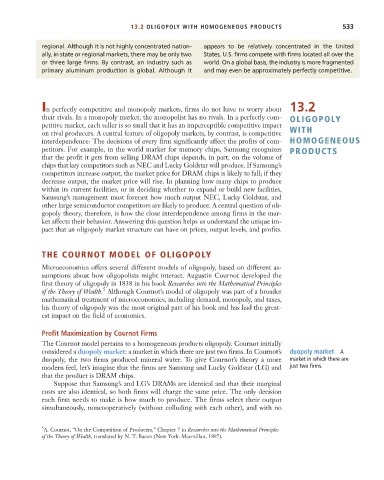Page 559 - Microeconomics, Fourth Edition
P. 559
c13marketstructureandcompetition.qxd 7/30/10 10:44 AM Page 533
13.2 OLIGOPOLY WITH HOMOGENEOUS PRODUCTS 533
regional. Although it is not highly concentrated nation- appears to be relatively concentrated in the United
ally, in state or regional markets, there may be only two States, U.S. firms compete with firms located all over the
or three large firms. By contrast, an industry such as world. On a global basis, the industry is more fragmented
primary aluminum production is global. Although it and may even be approximately perfectly competitive.
In perfectly competitive and monopoly markets, firms do not have to worry about 13.2
their rivals. In a monopoly market, the monopolist has no rivals. In a perfectly com- OLIGOPOLY
petitive market, each seller is so small that it has an imperceptible competitive impact
on rival producers. A central feature of oligopoly markets, by contrast, is competitive WITH
interdependence: The decisions of every firm significantly affect the profits of com- HOMOGENEOUS
petitors. For example, in the world market for memory chips, Samsung recognizes PRODUCTS
that the profit it gets from selling DRAM chips depends, in part, on the volume of
chips that key competitors such as NEC and Lucky Goldstar will produce. If Samsung’s
competitors increase output, the market price for DRAM chips is likely to fall; if they
decrease output, the market price will rise. In planning how many chips to produce
within its current facilities, or in deciding whether to expand or build new facilities,
Samsung’s management must forecast how much output NEC, Lucky Goldstar, and
other large semiconductor competitors are likely to produce. A central question of oli-
gopoly theory, therefore, is how the close interdependence among firms in the mar-
ket affects their behavior. Answering this question helps us understand the unique im-
pact that an oligopoly market structure can have on prices, output levels, and profits.
THE COURNOT MODEL OF OLIGOPOLY
Microeconomics offers several different models of oligopoly, based on different as-
sumptions about how oligopolists might interact. Augustin Cournot developed the
first theory of oligopoly in 1838 in his book Researches into the Mathematical Principles
5
of the Theory of Wealth. Although Cournot’s model of oligopoly was part of a broader
mathematical treatment of microeconomics, including demand, monopoly, and taxes,
his theory of oligopoly was the most original part of his book and has had the great-
est impact on the field of economics.
Profit Maximization by Cournot Firms
The Cournot model pertains to a homogeneous products oligopoly. Cournot initially
considered a duopoly market: a market in which there are just two firms. In Cournot’s duopoly market A
duopoly, the two firms produced mineral water. To give Cournot’s theory a more market in which there are
modern feel, let’s imagine that the firms are Samsung and Lucky Goldstar (LG) and just two firms.
that the product is DRAM chips.
Suppose that Samsung’s and LG’s DRAMs are identical and that their marginal
costs are also identical, so both firms will charge the same price. The only decision
each firm needs to make is how much to produce. The firms select their output
simultaneously, noncooperatively (without colluding with each other), and with no
5 A. Cournot, “On the Competition of Producers,” Chapter 7 in Researches into the Mathematical Principles
of the Theory of Wealth, translated by N. T. Bacon (New York: Macmillan, 1897).

